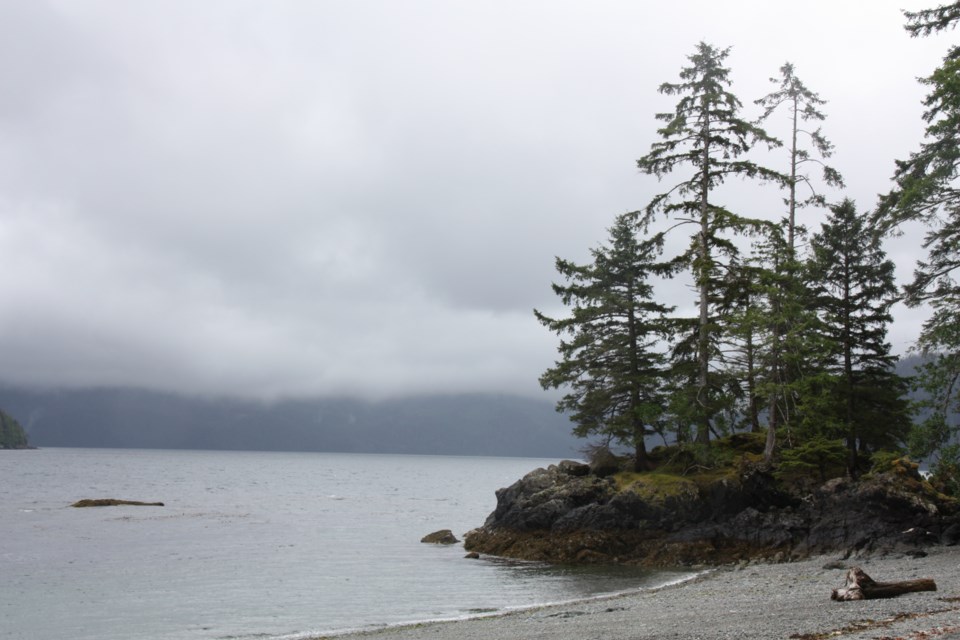“Why are we on a boat in the rain?” my wife asked me.
We were on a 20-foot Zodiac in open water near Moresby Island, the second largest island on Haida Gwaii. Our tour operators, Moresby Explorers, had saddled us in rain gear, gumboots and life jackets. We had set out through Cumshewa Bay, past abandoned logging operations that once harvested spruce trees used to manufacture mosquito bombers in the Second World War.
In Vancouver, visitors speak about Haida Gwaii as a sanctuary of nature and First Nations culture. In reality, that idealized vision, reinforced by vocal opposition against the Enbridge pipeline, co-exists with the blue-collar realities of depending on natural resources to make a living. This was apparent in the clear-cut forests we saw as we drove to our boat’s launch site.
The clouds were grey but had yet to pour until our guide and skipper, James, led us into Gwaii Haanas (“island of wonder”) in the Haida language), the National Park Reserve and Haida Heritage Site. Heading into the open waters of the Hecate Strait, the boat began to hop in the water and our faces were spritzed with saltwater. That’s when the rain started to sting our faces. At that point, I had no reply for my wife.
The answer would come moments later when we arrived in Tanu Village. This reserve was abandoned in the 1890s after a smallpox epidemic eviscerated the Haida population from up to 30,000 people to only 600 survivors.
Waiting by the beach as we disembarked was Walter, a member of the Haida Watchmen who oversee the village sites in the area. In traditional times, the watchmen guarded villages from attacks and were represented on totem poles as three hatted men. Today they serve as guides for these cultural relics.
Walter took us through the site, which has been left to decompose in accordance to Haida tradition, pointing out cedar beams that once formed the foundation of the village’s home and fallen mortuary poles commemorating significant members of the village. Newer trees and vegetation cover the remaining structures.
Afterward, Walter’s wife, Mary, led us on a bonus tour that saw us visit the grave of world-renowned Haida carver Bill Reid, whose lineage was traced to this village. She then guided us along a spongy forest floor path, through a creek, and up the side of a muddy hill to a waterfall and swimming hole that served as the source of water for the watchmen cabin.
“Best hike ever,” my wife declared on our way back.
After a couple of more stops in quiet bays to see harbour seals, bald eagles and ocelots, we spent the night on a floating lodge in Crescent Inlet. The next day we suited up in our rainwear again for the second half of our expedition.
One stop was Windy Bay on Lyell Island, the site of the Legacy Pole, which in August 2013, became the first totem pole erected in the area since the 19th century.
In 1985, Lyell Island was a battleground between environmentalists and the commercial logging industry. Protests and logging road blockades captured worldwide media attention and led to the creation of Gwaii Haanas. Carver Jaalen Edenshaw commemorated their efforts with a section on the Legacy Pole featuring the image of five linked men in gumboots entitled “Five Good People Standing Together.”
In Gwaii Haanas, we saw the remnants of traditional Haida life. Leaving the area, we found ourselves in the community of Tlell, where we were given a more contemporary view of Haida life and their efforts to create a sustainable economy from tourism. Located between the Tlell River and the ocean, Haida House is part of an effort to end the bear trade on the islands.
The trophy-bear hunting operation that once occupied the lodge, with its log and stone veneer facade, has been replaced by a Haida-owned business specializing in cultural tourism. Packages include visits to the Haida Heritage Centre in Skidegate and traditional feasts. In the hotel restaurant, appointed in Haida art, chef Peter Bowen offers simple, thoughtfully executed four-course dinners, including a smoked salmon pizzette, which makes the most out of local ingredients.
Near the lodge, I embarked on a three-hour hike to see the Pesuta Shipwreck, the stunningly decayed remnants of a log barge that washed up onto Tlell’s beach in 1928. The hike itself should have been easy.
A Haida Gwaii visitors blog recommended taking the inland east beach trail, which was better maintained, but I craved novelty on my walk back and ended on the muddy riverside trail, climbing over felled tree trunks and through forehead-poking branches.
“Why am I traipsing through mud?” I asked myself miserably, moments before the trailhead appeared. I was glad my wife had opted out of this particular adventure. Worst. Hiker. Ever.



